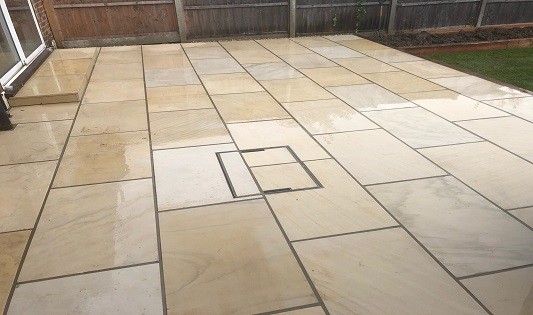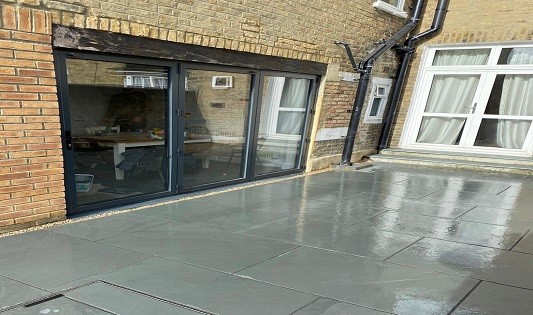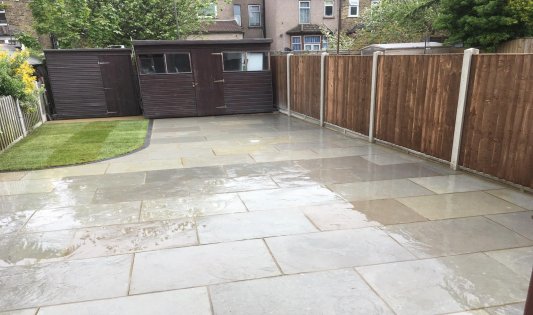How to choose the right paving for your garden. When planning your new patio there are many things you need to take into consideration when choosing the paving slabs for your project. Do you have a specific style of paving in mind? Are you looking for a flat, smooth or riven design? Do you have a colour preference? You need to make sure that the style and colour you choose will compliment your home and is in keeping with the style of your home. Paving slabs come in a variety of sizes. You can choose a uniform look having all pavers the same size, often chosen in a modern garden design. Or a mixed size pack which is often called a “patio pack” and has a selection of different sizes. These packs give you the flexibility to create a random pattern unique to your space. A popular trend this year is for large or oversize pavers in limestone, sandstone or porcelain in light, neutral colours. They create an indoor-outdoor effect as they look more like luxury tiling. These can be laid continuous or a broken-up layout. Budget is an important consideration as paving slabs do vary in price so you need to choose the right paver for your budget. Concrete paving is often the cheapest option. These come in a range of colours and are long-lasting and also recyclable. Natural stone like sandstone, limestone and granite are a very popular choice and are a mid-range option. They are hard-wearing and durable and offer a timeless look to your garden. Also available in a large selection of sizes and colours. If you are looking for a low-maintenance paver then porcelain is a good choice. More expensive than a natural stone it is a very hard-wearing paver, which is non-slip and provides resistance to frost, algae and stains. Are there different levels in your garden? Will you need a retaining wall to accommodate these and if so what materials do you want to use for this part of the project. What would look good against the paving, what material would you like to use, what colour, what size? For finishing touches you can choose to install a paving border to your patio in a different colour to provide a contrast to your paving and to add a visual definition to your patio. If you are planning a new patio and would like to discuss how to choose the right paving for your garden please get in touch to arrange a free consultation and quote. Please send an email to office@eastlondonlandscapes.com. We cover East London and West Essex.
Slate Paving
Slate paving is a hardwearing material which seems to improve with age. It is popular in gardens for its anti-slip properties which are due to it being very dense. It is non-porous meaning that is does not allow liquid to easily pass through and it dries quickly (rather handy in the UK with all our rain!) Being a natural stone it is better to use for the environment than a man-made stone. It is a good choice to bring the outdoors in as you can also install indoor slate pavers in your kitchen to provide a seamless flow through. There are options of a flagstone or a paving slab. Flagstones have a more natural and weathered look suited to a traditional garden. Slate pavers suit a more modern garden by providing a crisper look. Slate paving comes in many shapes and sizes and works in both traditional and modern gardens. Different sized riven paving works well in a cottage garden and more standard sizes work well in contemporary spaces. Slate paving is ideal if you are looking for a darker blue or grey colour paver which provides a good background for your plants and flowers. Regarding maintenance it should be given a thorough clean two or three times a year and regular sweeping to keep the area clean. If you would like to discuss a paving project please email office@eastlondonlandscapes.com to arrange a free consultation with one of the team.
Indian Sandstone Paving
When choosing paving slabs for a garden project Indian Sandstone is very popular and is chosen by many of our clients for their paving projects. It is available in a riven or a smooth sawn surface. Indian Sandstone is a natural, quarried rock that is cut and shaped into paving slabs. As it is a soft rock it is easy to cut and shape to create a curve or a specific design for a patio. It is a good quality paver and comes in a variety of colours and sizes. You can choose to have one size paver for your patio or a combination of the sizes. For maintenance of your paving sweep the patio regularly to remove any debris and wash with soapy water. Try to avoid using any cleaning products that contain acid as this can create rusting on the slabs. If you would like to discuss a paving project please email office@eastlondonlandscapes.com or call 020 3633 6413 to arrange a consultation with one of our friendly team. Our landscaping services cover East London . If you get a moment take a look at our website www.eastlondonlandscapes.com
Patios and Paving
Stone patios can look lovely, and are certainly hard wearing. The hardest part is actually laying them correctly. If you look at DIY websites and books, it seems to be a fairly straightforward task. In reality – it can be very difficult for people who don’t possess the skills, equipment and background knowledge to choose the right stone and lay it correctly. Over the past few years, the range of stone on the market has expanded substantially. It is no longer just a few traditional stones local to this country. Paving stone is being imported form all over the world, particularly India and China, and such stone is not always suitable for every location. There is, quite simply, no one size fits all approach to stone paving. Each job now has to be assessed individually, with specific site conditions such as sub-soil and soil type needing to be taken into account. Sub base levels can vary considerably. Then there is the question of the aspect of the garden, and which way it faces. Northern facing gardens experience slightly different climatic conditions to those gardens that face south. What about sealing the stone? Is it a good idea or not? Under what circumstances should natural stone be sealed? Faced with this plethora of questions, more and more people are turning to professional landscape contractors to do the job. Trained landscape contractors have the skills, knowledge and equipment to lay stone paving of any kind correctly and efficiently. They can also advise on the choice of stone, ensuring that it is suitable for your particular garden requirements. Using a landscape contractor reduces the risk of unexpected problems occurring during construction. If any such problems occur for example the discovery of hidden foundations underground, or unexpected pipes and wiring; a landscape contractor will know how to respond immediately. Another advantage is the simple fact that a landscape contractor may be able to take your ideas and make the final result even better than expected. Instead of laying a mono-colour block, the contactor could create patterns, or introduce some additional colour, which you might not otherwise have considered. Using the right product for the location can make a lot of difference to the long term maintenance thus keeping patios and stone pathways looking good for much longer. Talking to a hard landscape contractor can make financial as well as visual sense! If you would like to discuss a project please get in touch via our website www.eastlondonlandscapes.com, email office@eastlondonlandscapes.com or call 020 3633 6413 or to arrange a free consultation.






